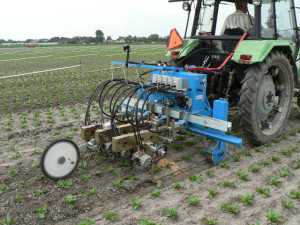High-Tech Weeders Have Potential For Vegetable Growers

Each hoeing tool on this weeder from F. Poulsen Engineering in Denmark is individually controlled by separate cameras.
Photo credit: F. Poulsen Engineering ApS.
Weeds an be a pesky, nagging problem for growers of virtually any crop. What makes things worse is the number of weed control tools available for California growers producing specialty crops, such as leafy greens, is rather limited. Growers in the Golden State also have to deal with numerous regulatory concerns.
With all of these challenges, developing mechanical options for weeding might seem like a high priority. Taking up the weed control torch, Steve Fennimore, Extension vegetable weed specialist at the University of California-Davis, recently requested funding to conduct testing on robotic weeders. He was turned down.
“What we’ve got here is a failure to communicate,” he said, borrowing the line from the 1967 movie “Cool Hand Luke.” He cites increasing labor costs, labor shortages, and old herbicides as the reason mechanical weed control needs to be brought to the forefront.
Weeding costs right now are between 4% and 10% of the production costs for conventional and organic vegetables. That doesn’t seem like a lot, but weed control is a chronic issue that needs to be successfully communicated to those in control of the purse strings, Fennimore says.
Prioritize Weeding
Part of the problem, he says, is that weeds are not going to put you out of business. The result is they are not considered a priority.
“Plus, we don’t have the herbicide resistance issues that they are fighting in cotton and soybeans,” Fennimore explains. “Vegetable growers are good integrated weed managers, but hand weeding is part of it, and those costs are increasing. In Europe, they have high labor costs and governments there have prioritized non-pesticide solutions. Because the labor supply is diminishing, [European growers] were forced to change.”
Mexico is rapidly changing, too, and that could impact U.S. growers. “If you look at the Mexican economy and the rate of industrialization and the demographics of labor, we need to be prepared for fewer farm workers,” he adds.
To date, a significant amount of work has been done in the U.S. in the area of robotic lettuce thinning, and in the last year, some Arizona and California lettuce growers have adopted the technology, Fennimore says. In fact, one grower recently told him he successfully weeded 10 acres in about nine hours. To thin 10 acres of lettuce by hand in the same amount of time would take 10 people to get the job done.
“The potential for labor use efficiency is there; it just needs to be recognized,” he adds.
Mechanical Options
Fennimore has identified three robotic machines he says have the potential to get the job done:
a unit from Italy-based Ferrari (Aziendainfiera.it/en/p/sarchiatrice-ferrari);
the IC-cultivator from Steketee, a company located in Netherlands represented in North America by Northern Equipment Solutions (Steketee.com/product/IC-Cultivator); and
the Robovator vision weeder from F. Poulsen Engineer-ing, a company in Denmark (Visionweeding.com).
According to Fennimore, the three weeders operate in similar ways. They use machine vision sensors to weed in the plant line by crop recognition, and the machines use the same type of cultivator.
“The cultivators remove weeds by pushing cultivator knives into the seed line to uproot weeds and withdrawing the knives to protect the crop plant. You have a split cultivator shoe that opens and closes, and the machines operate hydraulically,” he explains. “A camera detects the plant and sees the row pattern, much the same way as the current lettuce thinners. [The hydraulically-operated hoe blade] opens when it sees the crop and closes in between the two crop plants.”
Working With Herbicides
Fennimore says there are instances where robotic weeders and herbicides may work well in tandem, citing transplanted lettuce as an example. Although it is not labeled yet for use on transplanted lettuce, the BASF herbicide Prowl is being tested to determine if a label on leafy vegetables in California is warranted, he says.
Why transplanted lettuce? Fennimore says there is a trend in the Santa Maria area, which is a smaller part of the lettuce production zone, toward transplanted lettuce. These growers are turning their fields over fairly often as they have a longer season than in Salinas, and their rotational cycle is three crops or more. Using transplants helps these growers turn the crop quickly, allowing land to be cropped more often.
“By going to a transplanted lettuce, they can turn more crops and make more money on the same amount of land,” he adds, making the Prowl/robotic weeder plan a sound one. Plus, the grower is starting out with good weed control.
“If you have a robotic hoeing system to remove any escaped weeds, the potential appears to be there to greatly reduce the need for hand weeding and that is my goal,” he says. “It will help with the grower’s bottom line and it will help free up labor for more important things like harvesting.”










